The best home security system
Ring Alarm is the most comprehensive system, though Simplisafe has a more attractive design.
By Rachel Cericola
This post was done in partnership with Wirecutter. When readers choose to buy Wirecutter's independently chosen editorial picks, Wirecutter and Engadget may earn affiliate commission. Read the full guide to home security systems.
Peace of mind doesn't have to be pricey. Home security systems often require long contracts and pro installation, but there are smart systems you can install yourself that include a monitoring plan to keep tabs on it—and only when you want that. We found Ring Alarm to be the most affordable, comprehensive, and easy-to-use DIY home security system that has both self-monitoring and professional-monitoring options and doesn't lock you into a contract.
Ring Alarm is the most comprehensive system we tested, with the most affordable monitoring plan we found. You can expand it with a variety of Ring security cameras, including indoor, outdoor, and video doorbell cameras. It also integrates with several third-party devices via the Works With Ring program, which includes brands such as First Alert, GE, Kwikset, Leviton, Schlage, Yale, and others, giving you more customization choices than other systems offer. It's also one of the few systems to provide both arming and disarming via Alexa voice commands with a four-digit PIN. Plus, you get 24/7 live customer service.
SimpliSafe has a better-looking system than Ring, with voice prompts and support for Google Assistant as well as Amazon Alexa (but not Apple HomeKit). It also has add-ons such as a video camera, a doorbell camera, smoke alarms, and additional sensors. Unlike the Ring Alarm system, however, it doesn't offer outdoor cameras or self-monitoring options; you also can't add any non-SimpliSafe devices, and live customer service is available only from 9:00 a.m. to 12:00 a.m. Eastern.
Why you should trust us
In the process of writing this guide, we interviewed peers, home security consultants, police departments, and insurance agents. We also sent security companies detailed questionnaires about their products and services.
I've covered consumer electronics for more than 15 years and have tested scores of smart-home devices, from remotes and security cameras to AV receivers and speakers. As a former editor for Electronic House and Big Picture Big Sound, I've written buying guides for multiple consumer-electronics products, and I've written articles covering technology for The New York Times (which is now Wirecutter's parent company), Wired, Woman's Day, Men's Health, and other publications.
Who should get this
You've probably worried about the safety of your home at some point, but it's important to know that most homes and apartments will never be burglarized. According to the FBI, the number of property crimes dropped in 2017, continuing a trend of over 25 years. Still, if you want more peace of mind about the safety of your family and the security of your belongings, and if you want to know that someone will call emergency services should the need arise, a security system can play a valuable role. And although a home security system can't stop a determined burglar from breaking into your house, it can discourage someone from breaking in if they know you have it (PDF), frighten someone away if they do get in, summon cops or firefighters in case of an emergency, and save you anywhere from 8 to 15 percent on your home-insurance premium. "An alarm system might sit there for 10 years and do absolutely nothing," said Bob Dolph, a home security consultant who has spent decades in the business. "You only need it to work that one time."
Note too that security systems aren't just about crime prevention: Most have add-on sensors that can protect your home from fire, flood, and even temperature changes (to prevent pipes from bursting, for one thing). Also, many of these systems can integrate with other smart-home devices, such as thermostats, locks, and light bulbs. That means you can add, for example, a smart speaker to arm, disarm, and check system status with the sound of your voice, as well as trigger cameras or lights to go on based on alerts or your location.
You can find two types of security systems: professionally monitored and unmonitored. In the former, when an alarm goes off, a professional monitoring company receives a notification and then attempts to contact you and, if need be, your local emergency services. An unmonitored system leaves all the work up to you. That means you need to be on call, day and night, during work and vacation time, and ready to determine whether police, fire departments, or other emergency services need to be dispatched. Then, you need to make that call yourself. It's a big difference, and a professionally monitored system is fundamentally more secure than an unmonitored or self-monitored one.
But monitored systems also tend to have a service contract, which locks you into paying an often-pricey monthly fee for a set amount of time, typically one to five years. No-contract systems, which allow you to pay for monitoring services on a month-to-month basis rather than committing to a long-term arrangement, are becoming more common. These systems sometimes cost more up front for the hardware than pro systems that offer a discount in exchange for that lengthy service agreement. Paying for the equipment up front provides you with a lot of control over what you get, where you can put it, and how you use the service. And you can start and stop the monitoring service as many times as you want.
Once you decide what type of system you want, you need to pick what that system will include. Most security companies, whether they're DIY, professionally installed, professionally monitored, or self-monitored, will offer guidance if you're confused about what to choose. DIY systems are also modular, so you can easily add sensors and devices as you need them—perhaps a camera by the garage, say, or sensors on the sliding glass door upstairs.
The backbone of a home security system is the base station. This unit is what communicates with all of the security sensors and smart-home components in your house. Many connect to a home router, but if yours has Wi-Fi or cellular support, placement is more flexible. Contact sensors are the first thing you should buy alongside the base station; these attach to doors and windows and will alert you when they open. Other home security components include motion sensors, keypads, key fobs, cameras, glass-break sensors, and panic buttons.
How we picked
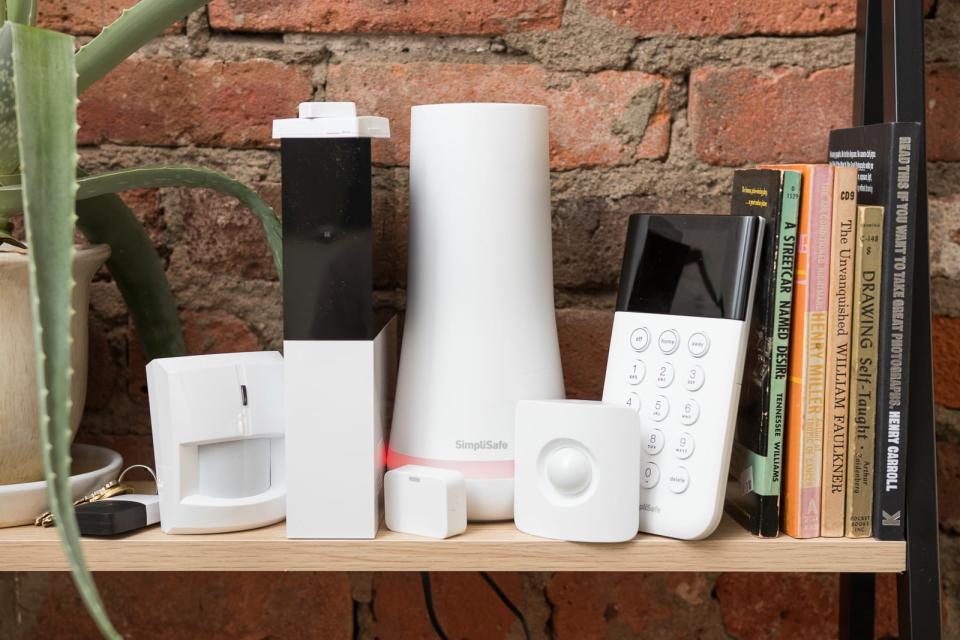
We looked for DIY systems that offered professional monitoring, both with and without a contract. Although some companies provide free or heavily discounted hardware in exchange for a service commitment that can last anywhere from one to five years, we found no-contract systems to be the most flexible. Some people may want to sign up for service only for when they or their partner is out of town, for instance. No-contract systems also cost less in the long run and allow you to be in total control of the equipment you use, as well as how and when you use and pay for monitoring services.
We didn't consider alarm systems that required professional installation. Pro-installed systems usually cost more, use equipment similar to that of DIY systems, come with long and typically onerous contracts, and often rely on the same monitoring companies that self-installed systems use, so they offer little advantage. A good example is the Vivint system, which we've reviewed separately and don't recommend for most people.
Next, we prioritized systems with consistently good ratings and looked at customer reviews on sites such as Yelp, Angie's List, and Amazon, when available. The basic packages varied, but we looked for home security systems that included the following:
Live 24/7 monitoring: Getting a text when danger arises is great, but unless you plan to be on call—all day, every day, including during vacation—you should choose a service that will contact emergency services when you can't.
A useful package of sensors and accessories: A home security starter package should come with door/window contact sensors and motion sensors. The size of your home will dictate what devices you need and how many of them. We also looked at what add-ons each system offered, including cameras, glass-break sensors, smoke alarms, panic buttons, and more.
An audible alarm: Signs and stickers could make a burglar think twice, but a piercing alarm will send them scurrying.
Battery backup: You shouldn't have to let your guard down when the power goes out. Most systems have some type of battery backup.
Cellular connection: A landline or Wi-Fi connection to the monitoring service can be cut or disrupted, so this provides a fail-safe option.
Keypad: A smartphone app is a must for use when you're away from home, but you shouldn't have to fumble with your phone when you're coming and going. A keypad can sit by the front door, making it easy to arm and disarm the system.
Fire prevention: Preventing break-ins is only one part of a security setup; most systems also offer protection against fire and carbon monoxide, although those devices cost extra.
UL approval: We asked manufacturers if each system met industry standards such as UL Standard 198 or (for systems with control panels) UL CP-01, though we didn't rule out systems on this basis because there's no federal requirement to meet those standards. (The UL CP-01 listing means that a control panel has features to reduce false alarms—that's a good thing, because false alarms can cost you money.)
How we tested
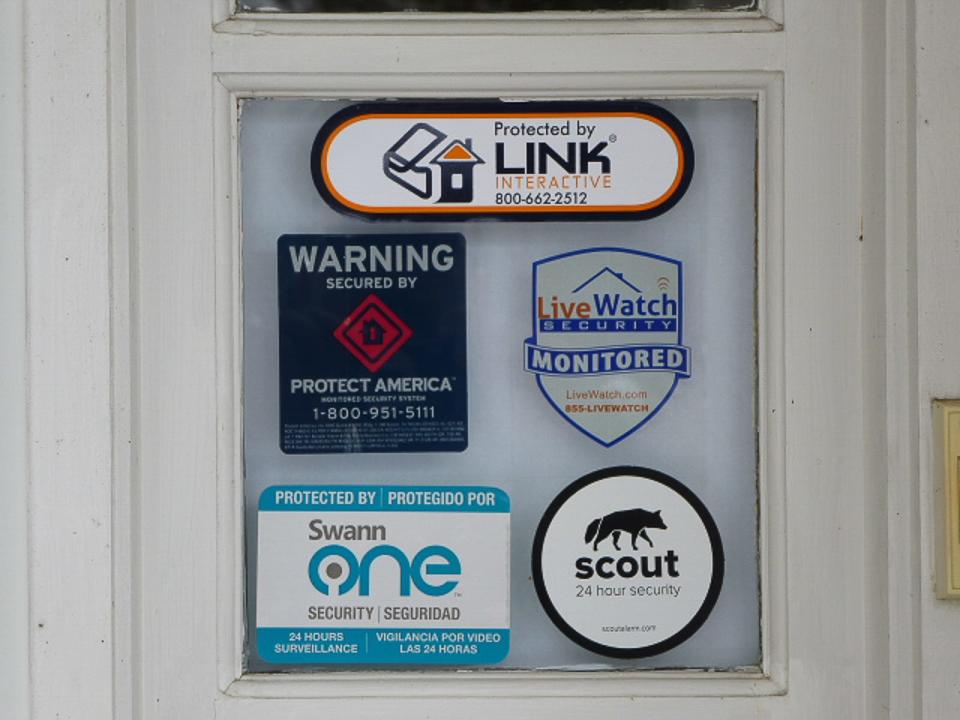
For several weeks, we walked in front of motion sensors, opened and closed contact sensors, and fired off sirens. We also tested cameras, keypads, and iOS/Android apps, when available. We armed, disarmed, and spied on each system from inside and outside the home, and we tested systems' battery backup when we cut their power.
To gauge reaction times for the monitoring company, we triggered each system a minimum of five times, using contact and motion sensors. However, keep in mind that the monitoring company's reaction time has absolutely nothing to do with the speed at which your local authorities will respond to the alarm—if they respond at all. In Los Angeles, for instance, all alarm calls must be verified, either by an eyewitness or through video or audio from a surveillance camera or microphone. Salt Lake City requires confirmation from a private security guard. Several cities also require a permit to even own and operate a home security system. Rules such as these are designed to limit the time and resources that police and fire departments waste on false alarms. Many municipalities will fine you for too many false alarms.
Our pick: Ring Alarm
Ring Alarm is the most comprehensive home security system for people who want no-contract 24/7 monitoring. With kits starting at $200, it's also among the cheapest. App control and self-monitoring are free, or you can opt for Ring's Protect Plus plan, which at $10 per month (or $100 per year) offers the most affordable live-monitoring option of any we tested. That monthly fee also includes cellular backup, fire protection, 60 days of video storage for an unlimited number of cameras, and a lifetime warranty for equipment damage. Ring Alarm offers as many (or more) security accessories as other packages we reviewed, allowing you to design the best system for your home. In fact, it's the only system that integrates indoor, outdoor, and video doorbell cameras without charging additional monitoring fees for online video storage. It also works with Alexa (which shouldn't be surprising, since Amazon is Ring's parent company), but not with Google Assistant or Apple HomeKit. Ring's handling of customer videos has generated controversy in the past, though the company states that it has since instituted better security measures (see Flaws but not dealbreakers).
The Ring Alarm system also has a self-monitoring option, something that's unheard of among professionally installed systems. That means even if you don't pay the monthly fee, the system will still alert you through your smartphone if it detects a threat, but you are responsible for contacting emergency services such as the police or fire department—so your phone needs to stay on and you need to be willing to field alerts, even at 2:00 a.m. It's nice that the system has a monitoring option, though, in case you don't always want that responsibility, such as when you're on vacation.
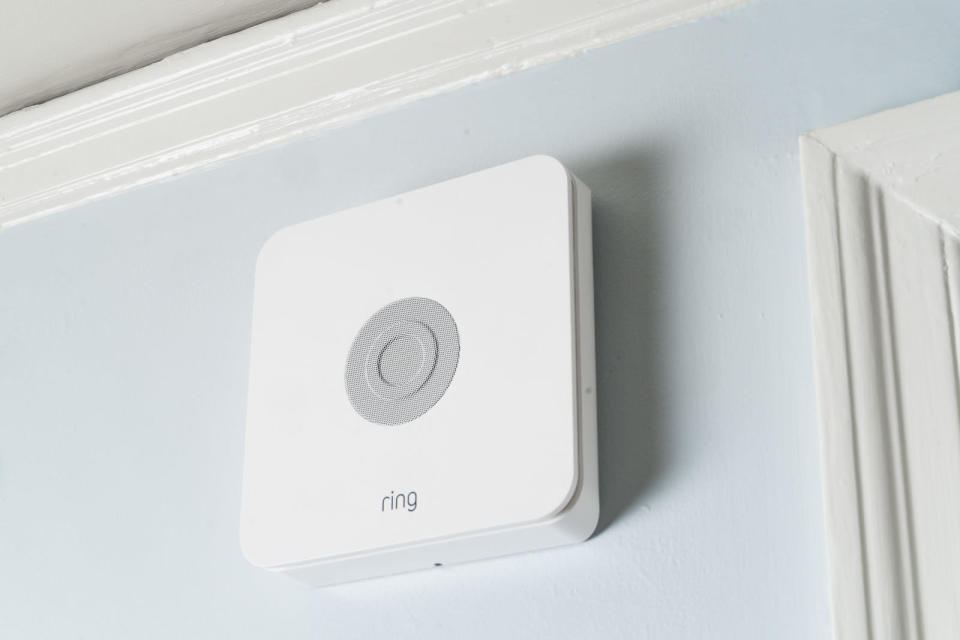
When we first reviewed the Ring Alarm system in September 2018, it was lacking several important add-ons as well as smart-home integration. The company has since updated the system, pushing it into our top spot. Currently, you can expand the Ring Alarm system with water leak sensors, a smoke/CO listener for existing detectors, a 95 dB external siren, and more. The Ring Alarm system also now integrates with the company's other devices, such as video doorbells and security cameras, as well as third-party devices via its Works With Ring program.
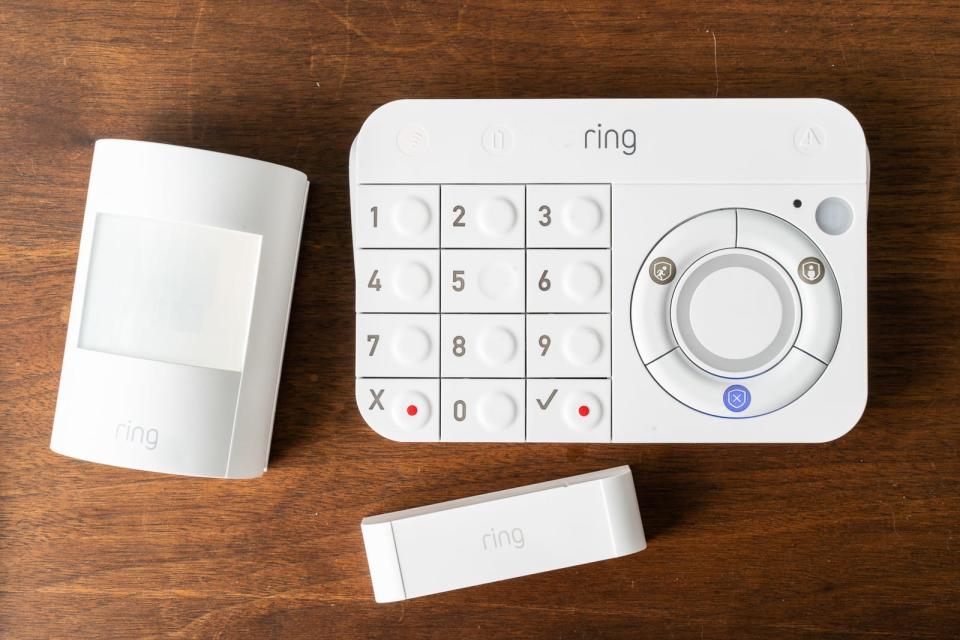
Ring's contact sensors and base station are a bit bulkier than those of some of its competitors. At 6.7 by 6.7 by 1.4 inches, the latter looks exactly like the original Wink Hub (that's not a compliment). But it has the ability to connect via Ethernet or Wi-Fi, so you can hook it to your router or place it in another area of your home to prevent wireless range issues affecting sensors and other devices. (Ring also sells range extenders, if you have problems with alarm components connecting to the base station. We didn't find them necessary in our 1,200-square-foot house, though.)
In our tests, the Ring Alarm system sent smartphone alerts within 4 seconds of the alarm being triggered, with email alerts as an option as well. You can set the siren to follow up within 30 to 180 seconds to hopefully frighten off any intruders. Verification calls from Rapid Response, a third-party partner service, came within 60 seconds of our 113-decibel siren (per our measurements) being triggered; you can disarm it by using the app or by giving your personally chosen safe word to customer service. The base station also alerted us when it was disconnected from power, and it delivered on its promise of 24 hours of battery backup.
Both the iOS and Android apps feature the ability to disarm or arm the system in home or away modes right from the home page, and they also offer one-touch access to live views and recordings on all connected cameras. You can find other devices under the settings menu. Ring has also added support for two-factor authentication (2FA), which adds an extra layer of security by prompting you to enter a passcode that comes to your mobile phone via text message. (To enable 2FA, which we strongly recommend, open your Ring app, tap Account,tap Two-Factor Authorization, and tap Turn on Two-Factor.)
The app also includes one-touch access to Ring Neighbors, a sort of neighborhood-watch social network that allows you to report and monitor suspicious activity in a zone that you can customize from about 500 feet up to 5 miles. You don't have to be a Ring device owner to be part of Ring Neighbors; there is a standalone Ring Neighbors app for iOS and Android devices. All users can post messages, photos, or links, which are expected to adhere to community guidelines. There has been a lot of controversy about Ring Neighbors, but we should stress that your recordings aren't shared with others automatically: The only way someone can view your activity is if you post it to Neighbors. If you decide to do that, anyone in your area can view your posts, including neighbors but also participating law enforcement officials, per the Ring Neighbors privacy policy.
Flaws but not dealbreakers
The Ring Alarm system has several accessories but still lacks a standalone glass-break sensor and a key fob, which has buttons to arm and disarm your system. A glass-break sensor is supposedly coming soon, but for now you can use the Alexa Guard feature on any Amazon Echo for the same task. For reference, everyday pricing on the Amazon Echo Dot is $50 (and often much less on sale), the same as the price of the Abode glass-break sensor and $15 more than SimpliSafe's.
Ring also doesn't support as many smart-home platforms as our other two picks. It works only with Alexa, although Google and Apple HomeKit support have been rumored since its launch. Currently, no DIY home security systems work with HomeKit, but if you're a Google Home owner, you may prefer to choose one of our other picks.
If you peruse Ring's social media accounts, you will see many customers still talking about The Intercept's January story that alleges that Ring allowed some employees inappropriate access to customers' videos. According to Ring, all of the recordings in question had either been publicly shared by the customer (through the company's Neighbors feature) or their use had been agreed to in advance by customers via specific written consent, so we recommend that potential buyers familiarize themselves with Ring's privacy policy. For more information, read Ring's blog post on how the Neighbors video-sharing feature works, and how your footage could end up in the hands of law enforcement.
Runner-up: SimpliSafe
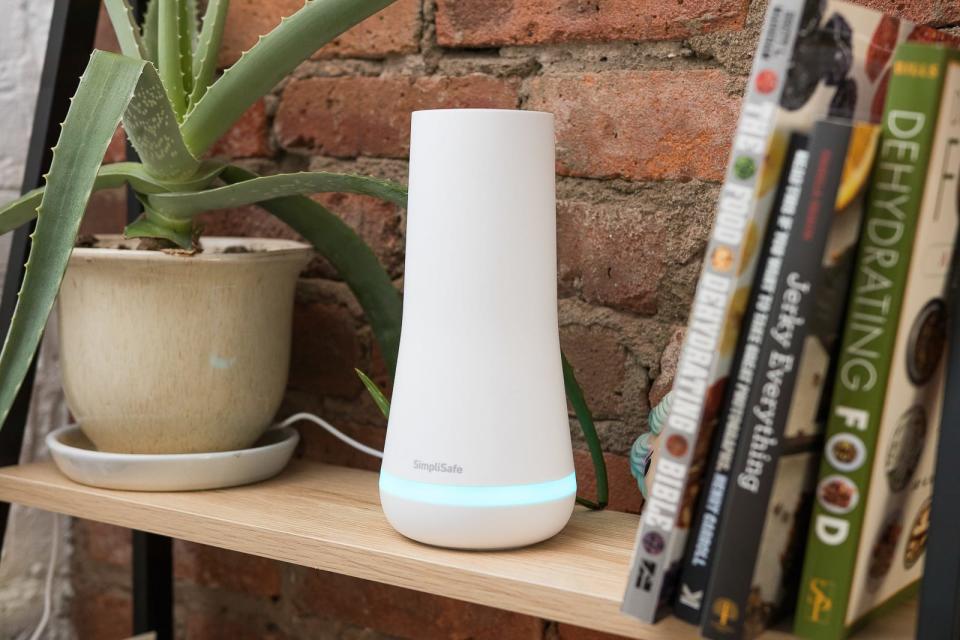
If you're a Google Home owner, if you want a more attractive-looking system, or if you just don't want to put security in the hands of Amazon (Ring's parent company), SimpliSafe is a flexible, affordable, and easy-to-use live-monitoring security option. It's one of the best systems we've tested, with customizable alarm triggers and consistent monitoring response times. We also found it easy to set up, scalable to small and large homes, and configurable with a variety of accessories, from entry and motion detectors to fire and CO sensors to leak and temperature sensors. SimpliSafe also works with Amazon Alexa and Google Assistant, allowing you to arm and check the system using only voice commands. It doesn't work with many third-party smart-home devices, though, and it isn't very useful without a monitoring subscription.
The $260 Essentials package includes the base station, a keypad, four entry sensors, one motion sensor, a yard sign, and two window decals. For $15 per month, you can add around-the-clock professional monitoring and a cellular connection, so the system can communicate with the monitoring service without a landline. The $25-per-month Interactive plan adds control via iOS and Android smartphone apps, push and email alerts, and 30-day event-footage storage for unlimited cameras, including the SimpliSafe Video Doorbell Pro, which is available separately. Without the $25 plan, you handle all controls via the keypad.
Like the Ring Alarm system, SimpliSafe is a no-contract security system. However, it has no self-monitoring option: If you cancel, you lose monitoring, remote access, and all smartphone alerts, though the sensors and sirens will still work, so you can at least set an alarm when you're home at night.
The SimpliSafe equipment is now in its third version, with a simpler and more stylish design for both app and devices. The base station is curvier and the sensors are smaller, but the range is better, promising connections to wireless sensors up to 800 feet away. We didn't go that far, but we were able to go about 40 feet in different directions, through walls to areas in the kitchen and dining room.
The base station is the brains behind the system. It includes Wi-Fi (you can also add a backup cellular connection via a subscription), which means it doesn't need to be physically connected to a router and so can sit in any convenient spot in your home. It also features a 24-hour battery backup, blue and red lights for alerts, UL certification, and an adjustable 95 dB siren (our tests actually found it closer to 98 dB), which, while not the loudest alarm, would definitely catch the attention of burglars in our 1,200-square-foot home. (If you want to go louder, or if you have a large home and need more than one siren, you can purchase a standalone 105 dB siren.)
Unlike the Ring and Abode base stations, the SimpliSafe base station provides voice prompts during setup, as well as when the system is arming, disarming, and triggered. When the system is triggered, the voice alerts you to enter your passcode before the system starts beeping. You can also integrate SimpliSafe into an Alexa smart-home setup, which enables you to arm the system in home or away mode or to check the system's status using voice commands.
SimpliSafe's contact sensors for doors and windows are small enough to be camouflaged when installed on white trim; the motion sensor is noticeable, but not an eyesore. When we placed the motion sensor about 6.5 feet off the ground, it was quick to respond, yet it was never triggered by a 30-pound dog. SimpliSafe also sells extra entry sensors, water and freeze sensors, glass-break sensors, panic buttons, smoke and carbon monoxide sensors, and temperature sensors. It offers indoor cameras, which aren't on a par with our camera picks but allow for Visual Verification, an opt-in feature that permits the monitoring service to view live video in your home to confirm there's an actual emergency before calling the cavalry—a system intended to reduce false alerts (and, as noted above, a requirement in some communities). SimpliSafe also offers a smart video doorbell with two-way audio that integrates with the SimpliSafe system; you can back up and store video recordings from its camera as part of the monthly Interactive plan as well.
Although entry and exit trigger times are customizable (up to 4 minutes, 15 seconds), the response time in our tests was always consistent: In every one of our tests, the COPS monitoring service called exactly 44 seconds after the alarm sounded. The service was always polite, and for security it requires a safe word to restore the peace.
Unlike some of the other no-contract systems we looked at, SimpliSafe does not have 24-hour customer service. The monitoring is 24/7, but if you have a hardware problem in the middle of the night, you may have to wait. You can contact customer service through email, Twitter, and Facebook, but the 800 number is available only from 9 a.m. to midnight Eastern, seven days a week.
In August 2019, the LockPickingLawyer YouTube channel posted a video showing how to hack into a SimpliSafe system using a $2 remote. SimpliSafe responded with a statement saying the system would alert users when it detected any type of interference. The company also questioned the video, claiming that there would need to be a perfect storm of circumstances for someone to successfully hack the system. Over a week, we ran more than 25 tests using two different 433 MHz remotes, with contact sensors located 6 to 26 feet away from the SimpliSafe Base Station, and we were unable to replicate the issue. Although our testing shouldn't be taken as conclusive, we believe this issue is unlikely to be a real-world problem for SimpliSafe customers who own the current system.
What to look forward to
Shipping in September, the SimpliSafe Smart Lock works with our runner-up system and will send smartphone alerts every time it's triggered. You can also customize it to make sure doors auto-lock, or lock only when you arm the security system. Access to the lock via the app is included only with SimpliSafe's $25 Interactive plan, but the company says a standalone lock is also in the works.
The competition
The Abode Smart Security Kit, our previous runner-up, is still a solid choice for some people. Abode has upgraded that version with 4G cellular backup and an onboard Z-Wave 500 Series chip, which provides a better range for sensors. We've encountered a few technical issues while long-term testing our previous also great pick, the Abode Iota, and so will continue to test and update accordingly. We no longer recommend it.
We used to recommend the Brinks Home Complete with Video system as an upgrade pick when it was under the LiveWatch brand, but the company has since changed the less-restrictive contract that made this system so appealing. It's still a good option if you're willing to spend $40 per month for a minimum of three years in exchange for discounted equipment, however. (The Brinks system costs $100 up front, plus a $20 activation fee.)
Scout has a no-contract system with Z-Wave support. However, it needs to be tethered to a router, it's bulkier than other no-contract options, and it won't send any smartphone alerts without the monitoring plan. Also, the company doesn't offer any sort of keypad option.
Cove matches SimpliSafe in almost every way. What kept it from being a pick was its app, which constantly locked us out, so we needed to enter a password for every log-in. Also, Cove currently ships equipment with a Yi camera but doesn't integrate it or any other cameras into the actual system.
The Frontpoint Security system, along with its Interactive plan, was our favorite home security system from 2013 to early 2016. Its equipment, monitoring plans, and features are almost identical to those of the Brinks system. However, Frontpoint's plans are slightly more expensive for the same level of service, its contracts are longer, its cancellation fees are onerous, and its pricing is less transparent than that of the Brinks system, which we no longer recommend anyway.
Don't be fooled by the Nest Secure system's good looks. It's a pricey system that gets pricier with everything you integrate. Expect to pay an extra Nest Aware fee for every camera you install, including the Nest Hello doorbell. Monitoring is provided by Brinks Home Security but doesn't include fire service with the Nest Protect. And although we appreciate geofencing, we had several errors with that feature during testing.
Both Link Interactive and Protect America have high fees and lengthy contracts. Link Interactive starts at $30 per month, with one-, two-, and three-year contract options, while Protect America has a three-year contract and a monthly cost that's dictated by your number of sensors.
We dismissed LifeShield based on negative customer service reviews and Ooma because the monitoring option doesn't involve an actual live person. We also tested out the Samsung SmartThings ADT Home Security and SwannOne systems but had problems with equipment and/or a lack of response from the monitoring services. We should also note that the SmartThings package has dropped 80 percent in price since we first reviewed it. We couldn't get a clear response on the status, so anyone considering a purchase should proceed with caution in case either company decides to discontinue support.
This guide may have been updated by Wirecutter. To see the current recommendation, please go here.
When readers choose to buy Wirecutter's independently chosen editorial picks, Wirecutter and Engadget may earn affiliate commissions.
